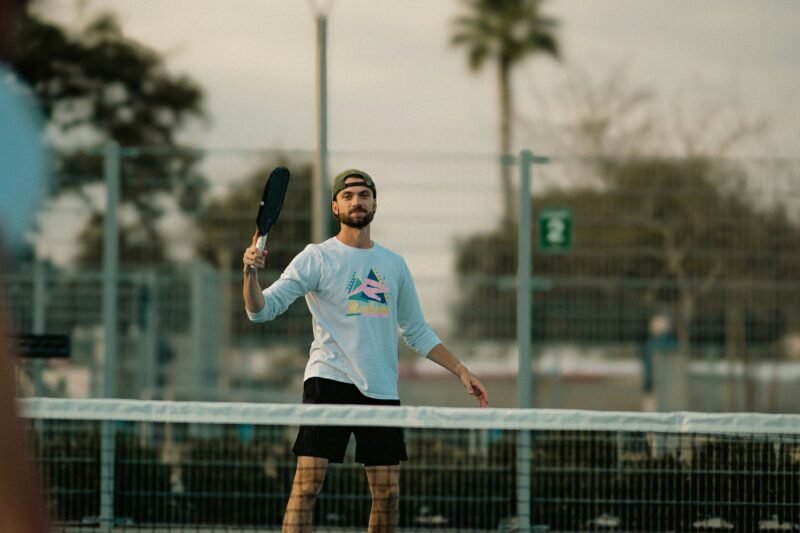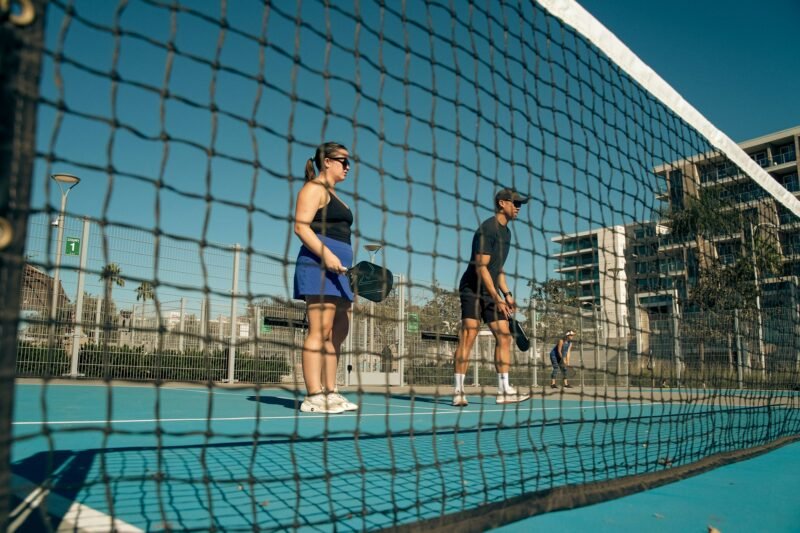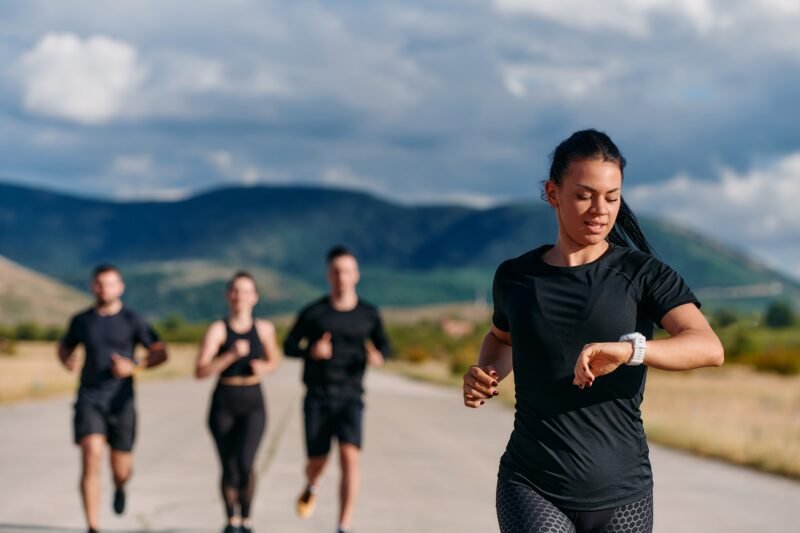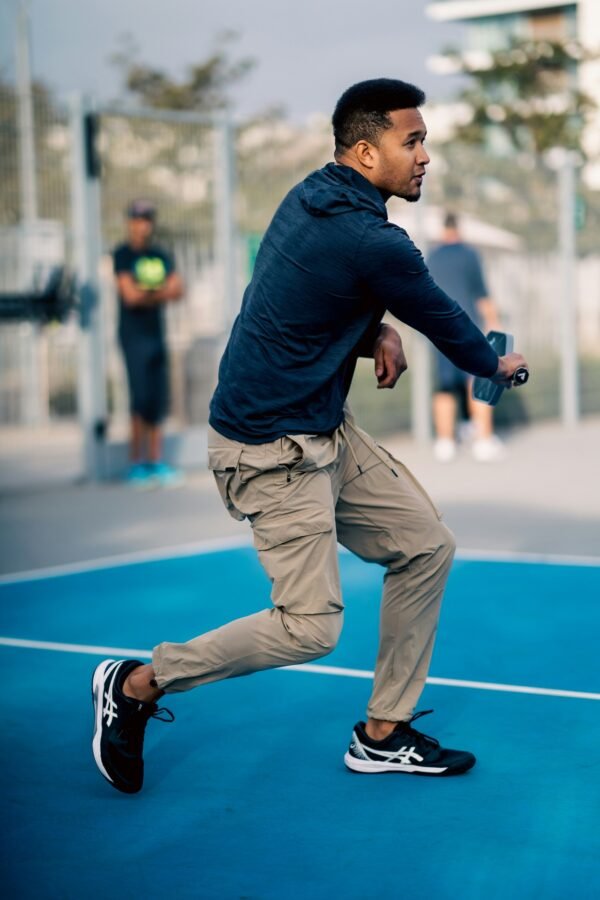Best Pickleball Warm-Up Routine: Get Ready to Play in 5 Minutes
Prefer to listen? Tap play below!
Essential Pickleball Warm-Up Routine for Beginners, Advanced, and Pro Players
No sport, pickleball included, would be complete without a warm-up. It’s not the fun, “scoring points,” part of the activity, but IT IS IMPORTANT!
The majority of movements in pickleball involve quick, sudden starts and stops, and also really dynamic plays. That type of athletic maneuvering requires all of the muscles and joints be salved up and ready to go. Failure to do this can lead to sub-optimal (aka crappy) performance, as well as injury.
Just starting? Try to work through some basic mobility and flexibility movements. These can be static and slow (and generally are at this stage). It’s about getting used to how your body moves at this point. Examples are arm circles and stretches, light cardio (light jog or jumping jacks, just to get the blood flowing and heart rate up). You may then wish to switch to dynamic ones. These can include movements which will help to open up and close your hip joints. This becomes very important in the short game as you advance in your play.
Advanced? What you need to do at this level is literally “tailor” your warm-up to what you need to prepare your body for. This should also be a very dynamic set of movements tailored to the “NEEDS” of the game. Examples here are lateral shuffles within the kitchen area, net shots, quick footwork, etc.

Pro / teaching pros? Your warm-up needs to specifically warm you up for pickling! This needs to be early in the day, especially before your first game of the day. Your warm-up should also be “agility” based for practical reasons as this makes the most sense. Many of you have a PT or a trainer that works to help train your muscles and do strokes or shot practices.
Warm-Up Routine for Pro Players
Professional athletes operate at the pinnacle of their sport, where every fraction of a second and every ounce of energy can determine the outcome of a competition. The high-performance demands placed on pro players necessitate a comprehensive warm-up routine that prepares both their bodies and minds for the rigors of competition. A well-structured warm-up is not merely a formality; it is a critical component of an athlete’s preparation that can enhance performance and reduce the risk of injury.
High-Intensity Interval Training (HIIT)
This effective warm-up strategy for pro players elevates cardiovascular readiness by incorporating short bursts of intense activity followed by brief recovery periods. HIIT not only increases heart rate but also enhances muscular endurance and metabolic efficiency, which are essential for sustaining peak performance throughout a match. By integrating HIIT into their warm-up, pro players can ensure that their bodies are primed for the explosive movements required in their sport.
Sport-Specific Skill Drills
In addition to cardiovascular readiness, sport-specific skill drills are vital for a comprehensive warm-up. For instance, tennis players might focus on serves and volleys, while basketball players may practice shooting and dribbling. These drills help to activate the specific muscle groups used during competition and reinforce muscle memory. By engaging in these targeted exercises, pro players can sharpen their skills and build confidence, ensuring they are mentally and physically prepared to execute their game plan effectively.
Mental Preparation Techniques
Mental preparation techniques, such as visualization, are equally important in a pro player’s warm-up routine. Visualization involves mentally rehearsing specific scenarios and outcomes, allowing athletes to create a mental blueprint for success. This practice not only enhances focus but also reduces anxiety, enabling players to enter the competition with a clear and confident mindset. By incorporating mental preparation into their warm-up, pro players can optimize their performance under pressure.
Why a Warm-Up Routine is Essential in Pickleball
Warming up before any physical activity is a must, and this is especially important for pickleball. The sport requires a lot of quick movements and a ton of agility and coordination. Warming up properly will prime the body for the specific physical demands of the game. The warm-up should be sport-specific and should include exercises that increase the heart rate and blood flow to the muscles. This helps to increase muscle “stretchiness” or elasticity and joint range of motion, which will, in turn, make movements that you’ll perform in the game easier to execute.

Another reason to warm up before running around on the pickleball courts is that it will significantly decrease the chance of injury. The warm-up is used to, well, warm up the muscles. Cold muscles and tendons that are used in rapid, dynamic movements such as the ones that are performed during a pickleball match will be much more likely to sprain, strain, or tear. The sport often requires sudden, quick, lateral movements, sudden bursts of short-distance speed, and stopping and starting. Many of these sorts of movements can be risky and are often the cause of injuries such as these. Preceding them with a proper warm-up routine will definitely lessen the risk, as warmer muscles and connective tissues are more pliable, stretch more, and are less brittle and likely to pop or tear.
Another thing that will be improved by a little warm-up session is focus, as it also provides psychological or mental benefits. Attention may be directed toward performance, breath, or technique, on getting faster, or on any number of focuses. This sort of mental readiness will definitely enhance performance. So will the competitiveness. A large part of this sport is the head game that’s played. There’s the player vs. player head game, and there’s also the one that constantly plays in our own heads. A little warm-up and focus time before hitting the courts will give you a little time to have your mind be clear and focused.
Last (but not least!) is that this is a great time to work on specific exercises that will help to prevent some of the common injuries that can occur on the pickleball courts. Strengthen the shoulders. Strengthen the wrists. Strengthen the legs and other parts of the body that are commonly injured while playing pickleball. Shaky and very unsure ankles should definitely be one of the first things that are worked on, as this deficit can easily be improved with a little bit of exercise and dedication. This work could save your ankles as the sport can be very tough on them due to the nature of it. This is your opportunity to prepare for that, as well as to better prime and prepare the body for the sport in general. Do exercises that mimic the moves that you’ll perform on the courts. Use this time as a more sport-specific strength and conditioning session as well.
Warm-Up Routine for Beginners
If appropriate, rephrase the text; if necessary, also alter the structure and formatting to correct things like overly-long lists. Whether or not you’re able to change the format or bullets is up to you. A proper warm-up is always important, given that your body needs to be ready for physical activity, both from a bodily and mental standpoint. But this is ever the case with beginner players. With beginner players, unlike more seasoned athletes, they’ve not had the same amount of repetition or exposure to movements, so it’s crucial that you provide them with a proper warm-up to follow.

The leader leads a group of athletes on a sunny day run, inspiring and guiding them towards their fitness goals with determination and unity
This warm-up should consist of:
- Dynamic stretches
- Basic footwork drills
- Light cardio
The purpose of the warm-up is to from a physical standpoint “get the blood moving,” allow for improved flexibility (thus decreasing the odds of injury) and give the body a preview of sorts so it is ready to work. The two goals of the warm-up, especially for beginners, are to prepare the body for work so it performs better but to also help athletes avoid injury.
The dynamic stretches they do should have a purpose. If you show an athlete an arm circle, for example, make sure you talk about why you want to do it (to loosen the shoulders) and do so at a consistent pace so they don’t stretch outside of their range of motion. If you show an athlete how to do leg swings, for example, be sure to cue them how to do it properly. You should focus on a slow, controlled swing that methodically combines the right amount of a normal range of motion (i.e., not over-swinging) to allow for proper stretching of the hips, but also be careful when lowering the leg back down (so you don’t injure the hamstring).
The same should be said for basic footwork drills. Introduce them to side shuffles, for example, and other, similar movements that focus on coordination, but make sure that the movements are what they will use later on during gameplay, on the field, and off. For the athletes, these movements serve to better their foot speed, but they will likely introduce athletes to movements that will help them later.
Next, be sure to have the heart rate raised higher than normal. How? With light cardio (jogging in place, for example, so the heart rate doesn’t spike). Only do so for a short period (5-10 minutes, depending on how conditioned your athletes are) so the athletes can handle it. Yes, you want the athletes to be mentally tough, but you also don’t want your players to be completely raw and injury-prone going into fundamental drills or a match.
Lastly, here’s one piece of advice I have for you: when you prepare this warm-up, make sure that the whole thing lasts a total of 10-15 or so minutes (you can demonstrate it beforehand), so the athletes are fresh and conditioned for what will happen next in the practice and the warm-up is more in the low to mid impact movements that aren’t too terribly difficult. Part of the reason you may need to modify the warm-up is because you may need to, on some days, be more deliberate in terms of introducing new movements. But then, you may have to re-teach different aspects of things to different people, in different ways, and that the warm-up before the workouts hasn’t been so involved that it takes up too much time, and you find yourself fatiguing quicker than you’d like to.
Warm-Up Routine for Advanced Players
For advanced players playing any sport, including pickleball, I believe there are specific differences that these rec players have from beginners or 3.0-3.5 players. The time they have spent hitting balls and playing games gives them a favorable position of understanding how their bodies react and how they feel when they perform at an elevated level of game-play.
Players at this level should primarily perform sport-specific drills. I love ladder agility exercises, as these are excellent activities to improve footwork.
Again, stretching is key. Similar to the previous groups, stretches should be dynamic in nature. The target muscle groups surround the legs, hips, and shoulders. Examples of stretches to incorporate include leg swings and arm circles.
The intensity is a very important piece of completing a warm-up routine.
The nature of the drills or exercises leads to a natural progression. A quick sum-up: sport-specific, agility, dynamic stretching routine, build-on intensity. Perform it from 15 to 20 minutes.
Tips for an Effective Pickleball Warm-Up Routine
Any pickleball player looking to up their performance and avoid injuries should be warming up whenever they play or practice. Simply put, this game that we love, with its fast starts and stops, quick changes of direction, and high-to-low-to-high exertion levels, puts our bodies through the wringer. We like it that way. In order to prove we are the best players and competitors, we must prepare our bodies for the onslaught we are about to bring to court.

Sometimes, how we compete is not as important as that we compete. We need to listen to our bodies. For every player, this will involve some personal tweaking. We know this to be true across the board. Your warm-up today might not look the same as it does tomorrow. You may need to do more today because you are feeling older. You may need to do more today because you are feeling out of shape. You may need to do more today because you aren’t feeling limber, or you may need to do less to conserve your energies for the match that is about to begin. If you are serious about your warm-up, no one (beyond possibly your doubles partner) will care what you are doing.
What you don’t want to do is become bored. Mixing things up additionally helps ensure that you indeed have everything covered. No two warm-ups will be completely the same. You don’t want to showboat, but you do want to be comprehensive. You also should encourage your partners and opponents to warm up with you.
Warming up before you play pickleball is important for all players (i.e. beginners, advanced, professionals). But beginners should approach it differently than a professional would. For beginners, warming up shouldn’t require fancy yoga poses and elaborate resistance-banding but rather, simple exercises to mimic the sport they are playing. Such routines should serve as teaching tools to help beginners learn the game and increase their mobility, balance, and coordination.
However, as you become more advanced at the sport, your warm-up routine should speak to your strengths/weaknesses. Therefore, even though basic warm-up programs are great, it is important to understand that a “one size fits all” program doesn’t work long-term. Self-discovery, as well as experiencing the freedom to try new skills in a safe environment (through dynamic stretching, visualization, and small drills), is vital to enhance/gain confidence and performance by teaching beginners how to control and move their bodies.
For everyone else (i.e. advanced players/professionals), their warm-up will be more sport-specific (i.e. include miniature drills/games to get their heart rate up) but as noted, their goals will be the same as beginners.
Whether you play pickleball for fun or it’s now your living, teaching beginners this basic dynamic routine can serve as an important stepping stone in their development. Show them how to do the warm-up exercises, then use these techniques in point play.
Then, because this is going to be their only activity (especially for younger players), push them in their warm-up with other exercises i.e. cardiovascular fitness, spatial awareness, timing, balance, visualization, and so forth. There is always a huge component of fun too! Doing this/anything similar will ensure you have a community (of players) learning from YOU, that’s improving every day! Enjoy the totally new experience.
Other Articles
Pickleball Tips for Playing with Hearing Loss
Pickleball Tips for Playing During Pregnancy
Pickleball Tips for Playing with Disabilities
Pickleball Tips for Playing with Injuries
Pickleball Tips for Playing in Humid Conditions
Pickleball Tips for Playing in High Altitude
Pickleball Tips for Playing on Wet Courts
Pickleball Tips for Playing at Night
Pickleball Tips for Playing in Cold Weather

